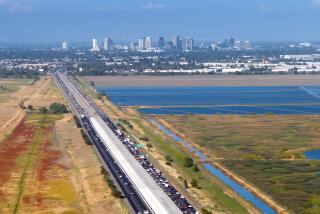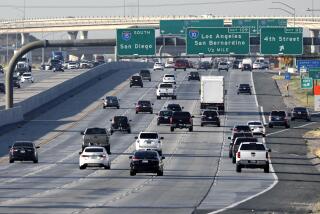Express road linking India’s capital to suburb not so swift
- Share via
NEW DELHI — Commuting the 15 or so miles to his office in Gurgaon, New Delhi’s emerging satellite city, used to take Tapash Majunder as much as three hours.
The main road linking the cities had for more than a year been partly obstructed by a subway construction project, and broken-down buses regularly blocked the few available lanes. Horse-drawn wedding processions, too, had a maddening tendency to trot onto the highway at rush hour and block traffic for miles.
“You’d just crawl your way through,” says Majunder, 50, a financial officer at a Gurgaon infrastructure company. “Sometimes in the wedding season you’d never reach home.”
India -- and New Delhi in particular -- has some of the most overburdened infrastructure in the world. Traffic crawls on jammed roads. Jets circle the airport for hours waiting for a landing strip. Power fails so often that private generators are the norm, at least for families and businesses rich enough to afford them. Water runs through the city’s pipes just two hours a day.
So it was with some anticipation that Majunder and tens of thousands of other Delhi commuters greeted the opening in January of a new limited-access tollway linking Delhi and Gurgaon. The sleek new elevated road, builders promised, would end the tortuous slog between the two cities and whisk travelers between them in just 15 minutes, unencumbered by traffic lights, roving bands of roadside magazine vendors or lumbering ox carts.
“The Delhi Gurgaon Expressway is a state-of-the-art expressway bench-marked to the highest international standards, aimed at providing commuters with a smooth world-class driving experience [and] significantly cutting down travel time,” D.S. Constructions, the builder, promised on its website.
So eager were commuters to take to the new road that a few, fed up with waiting for the finished highway to be officially opened by government dignitaries, staged their own impromptu ceremony a few days before the official launch, giving speeches, knocking over a concrete barrier and then whizzing off down the tantalizingly smooth expanse of concrete.
The tremulous excitement, however, did not last long.
As it turns out, when the tollway finally opened, builders had failed to erect road signs sufficiently big or prominent enough to help drivers choose the correct turnoffs.
Many errant motorists simply stopped, reversed and backed up on the expressway, a widely acceptable maneuver in New Delhi’s usual creeping traffic but disastrous on a road with a nearly 60-mph speed limit. Police were called in to hold up directional signs, direct traffic and sort out the carnage.
“The first day was chaos of the highest order,” Majunder says. “You pulled your hair out.”
Things were even worse at the highway’s spectacular 32-lane main toll plaza, the largest in India. Unaccustomed to following signs directing them to separate lanes for cash payments, pre-paid toll card use or automated tags, and unused to paying much of any attention to designated lanes for cars, trucks and buses, many drivers simply pulled into the handiest channel, quickly shutting down the automated lanes as confused motorists waved small bills and novice toll takers tried unsuccessfully to find a way to extricate misguided drivers.
In a few cases, all the to-and-fro at the booths led to automated toll gates dropping on stopped cars, cracking windshields and leading to shouting matches as drivers refused to move until insurance matters were sorted out.
Even at the cash lanes, toll booth attendants struggled to come up with appropriate change for motorists inevitably attempting to pay a 16-rupee toll, a figure set by government officials, with 20-, 50- or 100-rupee notes.
“It’s a very odd figure,” Majunder complained of the toll rate. “People pull out 100-rupee notes or 500-rupee notes and the cashier says, ‘I don’t have change.’ Then the driver says, ‘I don’t have anything else.’ And all your time is gone conversing.”
In the end, “everything was stalled” on the new highway, Majunder said. Backups at the expressway’s toll plaza stretched an hour or more, not the 30 seconds the highway’s builders had promised. Faith in infrastructure solutions for the giant nation wavered.
A month later, however, New Delhi motorists are settling in with their new 21st century expressway.
Tollway operators have cut the price of electronic toll tags by half to get more drivers out of the cash-only lanes. Bigger signs have been erected, and traffic police keep rickshaws and horse carts off the tollway. About 90,000 cars a day are plying the stretch, up from a predicted 76,000, and the toll plaza wait -- still a disappointing 30 minutes at rush hour -- is falling.
Majunder, whose car carries an electronic toll tag, now spends 10 minutes a day getting through the feared main toll plaza and no more than 50 minutes getting to work, down from a minimum of 80 minutes before the toll road opened.
He counts himself a satisfied customer.
More to Read
Sign up for The Wild
We’ll help you find the best places to hike, bike and run, as well as the perfect silent spots for meditation and yoga.
You may occasionally receive promotional content from the Los Angeles Times.






